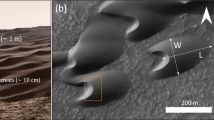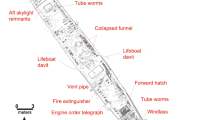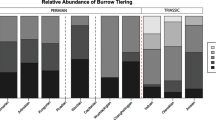Abstract
Wrinkle structures on sandy bed surfaces were present in some of the earliest sedimentary environments, but are rare in modern environments1. These enigmatic millimetre- to centimetre-scale ridges or pits are particularly common in sediments that harbour trace fossils and imprints of early animals2, and appeared in the aftermath of some large mass extinctions3. Wrinkle structures have been interpreted as possible remnants of microbial mats, but the formation mechanism and associated palaeoenvironmental and palaeoecological implications of these structures remain debated4,5,6,7. Here we show that microbial aggregates can form wrinkle structures on a bed of bare sand in wave tank experiments. Waves with a small orbital amplitude at the bed surface do not move sand grains directly. However, they move millimetre-size, light microbial fragments and thereby produce linear sand ridges and rounded scour pits at the wavelengths observed in nature within hours. We conclude that wrinkle structures are morphological biosignatures that form at the sediment–water interface in wave-dominated environments, and not beneath microbial mats as previously thought4,5,6,7. During early animal evolution, grazing by eukaryotic organisms may have temporarily increased the abundance of microbial fragments and thus the production of wrinkle structures.
This is a preview of subscription content, access via your institution
Access options
Subscribe to this journal
Receive 12 print issues and online access
$259.00 per year
only $21.58 per issue
Buy this article
- Purchase on Springer Link
- Instant access to full article PDF
Prices may be subject to local taxes which are calculated during checkout



Similar content being viewed by others
References
Noffke, N., Eriksson, K. A., Hazen, R. M. & Simpson, E. L. A new window into Early Archean life: Microbial mats in Earth’s oldest siliciclastic tidal deposits (3.2 Ga Moodies Group, South Africa). Geology 34, 253–256 (2006).
Gehling, J. G. & Droser, M. L. Textured organic surfaces associated with the Ediacara biota in South Australia. Earth Sci. Rev. 96, 196–206 (2009).
Pruss, S., Fraiser, M. & Bottjer, D. J. Proliferation of Early Triassic wrinkle structures: Implications for environmental stress following the end-Permian mass extinction. Geology 32, 461–464 (2004).
Porada, H., Ghergut, J. & Bouougri, E. H. Kinneyia-type wrinkle structures—Critical review and model of formation. Palaios 23, 65–77 (2008).
Porada, H. & Bouougri, E. H. Wrinkle structures—A critical review. Earth Sci. Rev. 81, 199–215 (2007).
Schieber, J. et al. (eds) Atlas of Microbial Mat Features Preserved within the Siliciclastic Rock Record (Elsevier, 2007).
Thomas, K., Herminghaus, S., Porada, H. & Goehring, L. Formation of Kinneyia via shear-induced instabilities in microbial mats. Philos. Trans. R. Soc. Math. Phys. Eng. Sci. 371, 20120362 (2013).
Hagadorn, J. W. & Bottjer, D. J. Wrinkle structures: Microbially mediated sedimentary structures common in subtidal siliciclastic settings at the Proterozoic–Phanerozoic transition. Geology 25, 1047–1050 (1997).
Flood, B. E., Bailey, J. V. & Biddle, J. F. Horizontal gene transfer and the rock record: Comparative genomics of phylogenetically distant bacteria that induce wrinkle structure formation in modern sediments. Geobiology 12, 119–132 (2014).
Mata, S. A. & Bottjer, D. J. The paleoenvironmental distribution of Phanerozoic wrinkle structures. Earth Sci. Rev. 96, 181–195 (2009).
Banerjee, S. & Jeevankumar, S. Microbially originated wrinkle structures on sandstone and their stratigraphic context: Palaeoproterozoic Koldaha Shale, central India. Sediment. Geol. 176, 211–224 (2005).
Neumann, A. C., Gebelein, C. D. & Scoffin, T. P. The composition, structure and erodability of subtidal mats, Abaco, Bahamas. J. Sediment. Res. 40, 274–297 (1970).
Hagadorn, J. W. & Mcdowell, C. Microbial influence on erosion, grain transport and bedform genesis in sandy substrates under unidirectional flow. Sedimentology 59, 795–808 (2012).
Sekiguchi, T. & Sunamura, T. Threshold for ripple formation on artificially roughened beds: Wave-flume experiments. J. Coast. Res. 212, 323–330 (2005).
Calner, M. & Eriksson, M. E. in Microbial Mats in Siliciclastic Depositional Systems through Time (eds Noffke, N. & Chafetz, H.) 29–35 (SEPM-Soc Sedimentary Geology, Vol. 101, 2012).
Bosak, T., Mariotti, G., Macdonald, F. A., Perron, J. T. & Pruss, S. B. Microbial sedimentology of stromatolites in Neoproterozoic cap carbonates. Ecosyst. Paleobiol. Geobiol. 19, 1–25 (2013).
Milligan, T. G. & Hill, P. S. A laboratory assessment of the relative importance of turbulence, particle composition, and concentration in limiting maximal floc size and settling behaviour. J. Sea Res. 39, 227–241 (1998).
Dietrich, W. E. & Perron, J. T. The search for a topographic signature of life. Nature 439, 411–418 (2006).
Cady, S. L., Farmer, J. D., Grotzinger, J. P., Schopf, J. W. & Steele, A. Morphological biosignatures and the search for life on Mars. Astrobiology 3, 351–368 (2003).
Bottjer, D. J., Hagadorn, J. W. & Dornbos, S. Q. The Cambrian substrate revolution. GSA Today 10, 1–7 (2000).
Gingras, M. et al. Possible evolution of mobile animals in association with microbial mats. Nature Geosci. 4, 372–375 (2011).
Mariotti, G., Perron, J. T. & Bosak, T. Feedbacks between flow, sediment motion and microbial growth on sand bars initiate and shape elongated stromatolite mounds. Earth Planet. Sci. Lett. 397, 93–100 (2014).
Chen, W. F. The Civil Engineering Handbook 1–2904 (CRC Press, 1995).
Nielsen, P. Dynamics and geometry of wave-generated ripples. J. Geophys. Res. 86, 6467–6472 (1981).
Miller, M. C. & Komar, P. D. Oscillation sand ripples generated by laboratory apparatus. J. Sediment. Res. 50, 173–182 (1980).
Acknowledgements
G.M. and T.B. were supported by NASA Astrobiology Institute award NNA13AA90A, and NASA Exobiology award 6927184. G.M. was supported by a W.O. Crosby Postdoctoral Fellowship. J.T.P. was supported by the NSF Geomorphology and Land Use Dynamics Program under award EAR-1225865. We would like to thank K. Bergmann for thoughtful discussion and M. O’Grady for support in the lab.
Author information
Authors and Affiliations
Contributions
G.M. conceived this study, designed and executed the experiments, and analysed the results. All authors interpreted the results and wrote the paper.
Corresponding author
Ethics declarations
Competing interests
The authors declare no competing financial interests.
Supplementary information
Supplementary Information
Supplementary Information (PDF 650 kb)
Supplementary Movie
Supplementary Movie (WMV 9375 kb)
Supplementary Movie
Supplementary Movie (WMV 8442 kb)
Supplementary Movie
Supplementary Movie (WMV 6538 kb)
Supplementary Movie
Supplementary Movie (WMV 6213 kb)
Supplementary Movie
Supplementary Movie (WMV 3877 kb)
Supplementary Movie
Supplementary Movie (WMV 7403 kb)
Supplementary Movie
Supplementary Movie (WMV 6965 kb)
Supplementary Movie
Supplementary Movie (WMV 7497 kb)
Rights and permissions
About this article
Cite this article
Mariotti, G., Pruss, S., Perron, J. et al. Microbial shaping of sedimentary wrinkle structures. Nature Geosci 7, 736–740 (2014). https://doi.org/10.1038/ngeo2229
Received:
Accepted:
Published:
Issue Date:
DOI: https://doi.org/10.1038/ngeo2229
This article is cited by
-
Searching for biosignatures in sedimentary rocks from early Earth and Mars
Nature Reviews Earth & Environment (2021)
-
Early Triassic wrinkle structures on land: stressed environments and oases for life
Scientific Reports (2015)



